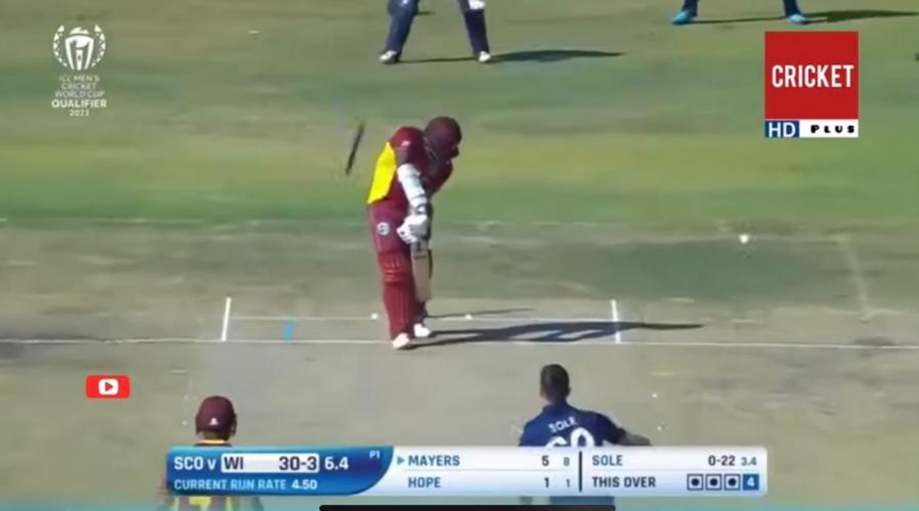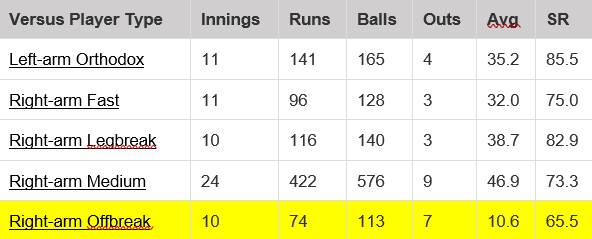By Ronan Alexander
Scotland fell agonisingly short of qualifying for the World Cup in India later this year despite a heroic campaign from the squad. Doug Watson’s side claimed victories over full member sides Ireland, West Indies and Zimbabwe as well as Oman and UAE. However, the Scots lost out to the two sides who made it to India, in Sri Lanka and Netherlands. Here, we’ll have a look at some tactical things Scotland did well across the tournament whilst having a deeper look into how batters got their runs and where the bowlers got their wickets.


Match 1
Ireland 286-8
Scotland 289-9
The opening over set the tone for how Scotland managed to control the powerplay with the ball during the tournament. Brandon McMullen nicked off Paul Stirling with the second ball of the match before trapping Andrew Balbirnie first up to reduce Ireland to 1-2. Chris Sole bowling rockets at the other end forged the best opening combination of the competition. McMullen’s ability to swing and nibble the ball both ways, partnered by Sole’s raw pace made it extremely difficult for batters to play. Commentators expected Safyaan Sharif to take the new ball. However, in Cricket World Cup League 2 (CWCL2), Sharif only took 8 wickets in 100 overs with a strike rate of 75 during the first 10 overs, meaning the Scots changed up their powerplay plans and let Sharif operate in the middle overs and at the death where he had more success.

McMullen and Sole also took their wickets in good time too. McMullen had the third best powerplay average (13.22), whilst Sole was sixth best (17.75).
The partnership of George Dockrell and Curtis Campher brought flashbacks of that T20 loss the last time the sides met. Both good players of spin, Michael Leask and Chris Greaves only bowled 8 overs between them, but Scotland couldn’t force the breakthrough as Ireland posted 286 which was around par for the early stages of the comp.
In reply, despite the early loss of Matthew Cross, Scotland negotiated the powerplay well and posted (56-1), the highest score in the first 10 overs for Doug Watson’s side. The middle order faltered but Mark Watt and Michael Leask provided an unbelievable partnership to get Scotland a memorable win in dramatic fashion off the last ball.
Leask hit nine maximums in the tournament, but notably was the second best six hitter in the tournament.

Match 2
Scotland 282-8
UAE 171 all out
After a poor start with the bat, Scotland struggled to get any real momentum in their innings as they were stuck at 48-4. Tweaking the top order is something that I would support. Cross has excellent numbers at 5, most recently his 58 against New Zealand last summer and George Munsey has a strong record as an opener and hasn’t had much success at number 4 in ODI’s, despite averaging 44 when batting 5. I’ have Munsey opening, Berrington at 4 and Cross at 5.
Matthew Cross ODI career by batting position

George Munsey ODI career by batting position

However, skipper Richie Berrington stood up and provided the glue that was required. A couple of 50 partnerships between Berrington and Leask then Greaves still left the Scots slightly behind the game at 166-6 and then 172-7. However, a 110-run stand between the captain and Mark Watt got Scotland up to 282-8.
In the second innings, the powerplay was again excellent with UAE three down before the move to bowl Sharif in the middle again paid off. He grabbed 4-20 from 6.3 overs as the men in blue ran out victors by 111 runs. The only seamer to take more wickets in the middle overs than Sharif across the competition was Josh Little.
Match 3
Scotland 320 all out
Oman 244-9
A match that will be remembered for Brandon McMullen fully announcing himself as a top order batter with his maiden ODI century after showing excellent stability and intent against both seam and spin throughout his international career so far.
Brandon McMullen v bowling type in ODI’s

Chris Greaves 5-53 wrapped up the win. He took 8 middle overs wickets which was only bettered by Sri Lankan spin twins Maheesh Theekshana and Wanindu Hasaranga. The only thing to nit-pick from this game is if it was wrapped up sooner, that net run rate equation in the final match could have had a different outcome.
Match 4
Sri Lanka 245 all out
Scotland 163 all out
Scotland’s first defeat of the competition despite an excellent bowling performance the team can take a lot of positives from. Bowling first, an early wicket was crucial as Kusal Mendis poor powerplay record gave Scotland the opportunity of two early breakthroughs. And they got it. Despite boasting an ODI average of 36, Mendis only averages 15.5 in the first 10 overs whilst striking at just 63 showing his struggles against the moving ball, further enhanced by the first innings conditions in Zimbabwe. He made 1(16) as Chris Sole got those two early scalps. Scotland went very seam heavy up front with the Sri Lankan top order batters all boasting impressive numbers against spin. Mark Watt didn’t feature until the 21st over.
Knowing and exploiting opponents’ weaknesses was going to have to be something Scotland take advantage of to ensure they get as many things in the game go their way as possible. This was perfectly done for Sri Lankan skipper Dasun Shanaka.

Shanaka was dismissed by Chris Greaves first ball. However, the run chase was tricky, and the batters found it hard to deal with Theekshana in particular. His carrom ball style of mystery spin bowling is unique and something the Scottish players probably haven’t really faced before and he bowled very well, showing why he goes for so much money in franchise T20 competitions around the globe.
Match 5
West Indies 181 all out
Scotland 185-3
The West Indies were clearly vulnerable and their defeat against the Netherlands made their chances of qualifying extremely slim. However, Scotland made this game look so easy. Their top order simply couldn’t handle the movement of McMullen. There was one other dismissal I found particularly satisfying. I put in my pre-match notes about Kyle Mayers being more vulnerable to the ball coming into him early in his innings. Chris Sole came around the wicket, angled the ball in and sent his off-stump cartwheeling to the right of Matthew Cross.


I didn’t manage to watch any of the run chase, but it seemed to be done at a canter and it was great to see Cross join the party with a magnificent unbeaten 74.
Match 6
Scotland 234-8
Zimbabwe 203 all out
Scotland put on 56 for the first wicket, their highest opening stand of the tournament. Zimbabwe should have given the new ball to Tendai Chatara who gets the most movement and could’ve exploited those early conditions in his favour, although Blessing Muzarabani and Richard Ngarava bowled well and in the right areas, but couldn’t find that early wicket. Valuable contributions got Scotland to a total they could defend in 234 and did so expertly. This was probably the best I’ve seen Sole bowl. Zimbabwe couldn’t handle him as he clocked 94mph and I wouldn’t be surprised if there are any injuries to seam bowlers in The Hundred, that he goes and picks up a last minute deal.
Sikandar Raza was always going to be a key wicket. He had been dismissed several times to the short ball as shown below.

The plan was almost perfect. McMullen set him up with three away swingers before banging one in short, but unfortunately the catch was dropped in the deep with him on 6. However, his other weakness is leg-spin, being dismissed every 22 balls in his career and he holed out to long off from the bowling of Chris Greaves as Scotland recorded another memorable win.
Match 7
Scotland 277-9
Netherlands 278-6
Scotland unfortunately fell at the final hurdle but can take so many positives from their campaign. Brandon McMullen scored another century as the Scots posted 277-9. The Netherlands were the best death bowling side in the tournament, with Bas de Leede particularly impressive. He picked up the most wickets in the last 10 overs in the tournament (10), whilst only going at an economy rate of 6.24 in this stage of the game. This meant Scotland had to cash in during the middle overs, which they did. The Dutch spinners lacked potency and struggled to prevent runs. Shariz Ahmad and Saqib Zulfiqar both went at over a-run-a-ball during the middle overs whilst Clayton Floyd and Aryan Dutt averaged 102 and 58 during overs 11-40, which Scotland took advantage of.
In the chase, de Leede backed up his 5 wicket haul with 123 runs with the bat in arguably one of the best ODI performances in memory. Before that, Michael Leask was used expertly straight after the powerplay to exploit both Netherlands openers weaknesses.
Max O’Dowd versus bowling type in ODI’s since 2020

Vikramjit Singh versus bowling type in ODI’s since 2020

Leask dismissed both batters within the first 3 overs of his spell. However, De Leede’s knock will live long in the Dutch memory as they progressed to the World Cup and I personally think it’s fantastic that an associate nation will be there and I hope they do well and cause more ‘upsets’ if you can call them that.
